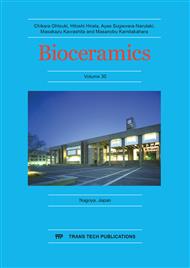p.244
p.250
p.256
p.262
p.268
p.275
p.283
p.289
p.297
Inhibitory Effects of Zoledronic Acid-Loaded Bioresorbable Carrier on Osteosarcoma
Abstract:
Calcium phosphate cements have attracted much attention as a drug carrier for local administration of bisphosphonates which are widely used to treat bone diseases such as osteoporosis and bone tumors. In the present study, to design the novel drug delivery carrier for bone metastasis without undesirable side effects, zoledronic acid (ZOL) loaded-bioresorbable β-tricalcium phosphate (β-TCP) cement was fabricated on the basis of chelate-setting mechanism of inositol phosphate (IP6) using ZOL loaded-β-TCP powders. In order to examine the minimally effective concentration of ZOL on osteosarcoma with no effect on osteoblast viability, cells were treated with ZOL. At a concentration over 10 μM, ZOL significantly inhibited the proliferation of osteosarcoma, whereas osteoblasts proliferated normally. On the other hand, the ZOL showed concentration-dependent adsorption to IP6/β-TCP powders through chemisorption. Based on these results, we have fabricated ZOL loaded-IP6/β-TCP cements and evaluated the anti-tumor effect on osteosarcoma. We found that ZOL loaded-IP6/β-TCP cements have an inhibitory effect on osteosarcoma and induced apoptotic like-cell death. These results suggest that ZOL loaded-IP6/β-TCP cements are promising materials to develop the local treatment for bone metastasis.
Info:
Periodical:
Pages:
297-302
Citation:
Online since:
October 2018
Authors:
Price:
Сopyright:
© 2018 Trans Tech Publications Ltd. All Rights Reserved
Share:
Citation:


